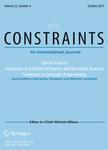版权所有:内蒙古大学图书馆 技术提供:维普资讯• 智图
内蒙古自治区呼和浩特市赛罕区大学西街235号 邮编: 010021

作者机构:Univ Glasgow Sch Comp Sci Sir Alwyn Williams Bldg Glasgow G12 8QQ Lanark Scotland
出 版 物:《CONSTRAINTS》 (约束)
年 卷 期:2017年第22卷第1期
页 面:50-72页
核心收录:
学科分类:08[工学] 0812[工学-计算机科学与技术(可授工学、理学学位)]
基 金:Engineering and Physical Sciences Research Council [EP/K010042/1, EP/N508792/1] EPSRC [EP/K010042/1] Funding Source: UKRI
主 题:Most-stable matching Blocking pair Polynomial-time algorithm NP-hardness Integer programming model Constraint programming model Empirical evaluation
摘 要:The Hospitals / Residents problem with Couples (hrc) models the allocation of intending junior doctors to hospitals where couples are allowed to submit joint preference lists over pairs of (typically geographically close) hospitals. It is known that a stable matching need not exist, so we consider min bp hrc, the problem of finding a matching that admits the minimum number of blocking pairs (i.e., is as stable as possible). We show that this problem is NP-hard and difficult to approximate even in the highly restricted case that each couple finds only one hospital pair acceptable. However if we further assume that the preference list of each single resident and hospital is of length at most 2, we give a polynomial-time algorithm for this case. We then present the first Integer Programming (IP) and Constraint Programming (CP) models for min bp hrc. Finally, we discuss an empirical evaluation of these models applied to randomly-generated instances of min bp hrc. We find that on average, the CP model is about 1.15 times faster than the IP model, and when presolving is applied to the CP model, it is on average 8.14 times faster. We further observe that the number of blocking pairs admitted by a solution is very small, i.e., usually at most 1, and never more than 2, for the (28,000) instances considered.